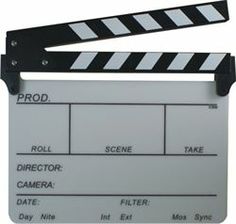

However, electronic timecodes can still drift during a long shooting day, so the clapper sticks on the clapperboard still need to be closed together in order to ensure there is a way of manually synchronizing the footage and audio if matching the digital timecode fails. The timecode displayed on the clapperboard will have been jam synced with the internal clock of the camera so that in theory it should be easy for an editor to pull the timecode metadata from the video file and sound clip and synchronize them together. In recent years sticks with calibrated color stripes have become available.ĭigislates are simply clapperboards with inbuilt electronic boxes displaying SMPTE time codes. The clapper sticks traditionally have diagonally interleaved lines of black and white to ensure a clear visual of the clap in most lighting conditions. Modern clapperboards generally use a pair of wooden sticks atop either a whiteboard or a translucent acrylic glass slate (the latter being easily legible via the light coming through it from the scene about to be shot). Traditional clapperboards consisted of a wooden slate with a hinged clapper stick attached to its top. Because of these technical limitations, the film industry has continued to use double-system recording for professional-quality film projects. With such footage, cutting to the next shot when an actor's lips stop moving will risk cutting off their last syllable, unless the soundtrack is copied and edited on a separate system, and actors must be directed to pause to allow for such cuts. Since the sound playback head cannot block the projector gate and must be placed after the gate, the soundtrack must be offset by several frames (usually 28, 26, or 18 ahead) to maintain sync with the frame in the gate.

Second, footage from single-system recording is difficult to shoot and edit. First, single-system recording of sound-on-film is "decidedly inferior in audio quality" to traditional double-system recording. However, single-system recording did not render clapperboards obsolete. Methods were later developed to directly record sound to film (technically, a magnetic stripe on film) as part of a single system integrated with the film camera (so-called single-system recording), which was most commonly used with small formats like Super 8 film. (For early sound films, playback of the audio track was synchronized during post-production with sound-on-disc techniques, and the audio track was later added directly to the release print with sound-on-film techniques.) Failure to use clapperboards can prevent the film editor from synchronizing the visual images on film footage with the accompanying audio recordings, as actually happened with the long-delayed film Amazing Grace. During a film shoot, the audio track was always recorded by the audio engineer with a separate system on separate media (so-called double-system recording). Purpose įinding a way to synchronize visual and audio tracks was essential to traditional filmmaking because film stock reacts to light, not sound. Since each take is identified on both the visual and audio tracks, segments of film are easily matched with segments of audio. The two tracks can later be precisely synchronized by matching the sound and movement. The shutting of the filmsticks is easily identified on the visual track, and the sharp "clap" noise is easily identified on the separate audio track. The slate displays the name of the production, the scene and "take" about to be performed, and similar information a camera assistant holds the clapperboard so the slate is in view of the cameras with the clapper sticks already open, speaks out information for the benefit of the audio recording, then claps the clapper sticks shut.

The clapperboard combines a chalkboard slate or acrylic board with a set of clapper sticks across the top. Leon (1903–1998) a pioneer sound engineer. The clapboard with both the sticks and slate together was a refinement of Leon M. Thring (father of actor Frank Thring), who later became head of Efftee Studios in Melbourne, Australia. The clapper as two sticks hinged together was invented by F. In the silent era the principal requirement of film stock identification during a day's shoot was the slate.


 0 kommentar(er)
0 kommentar(er)
